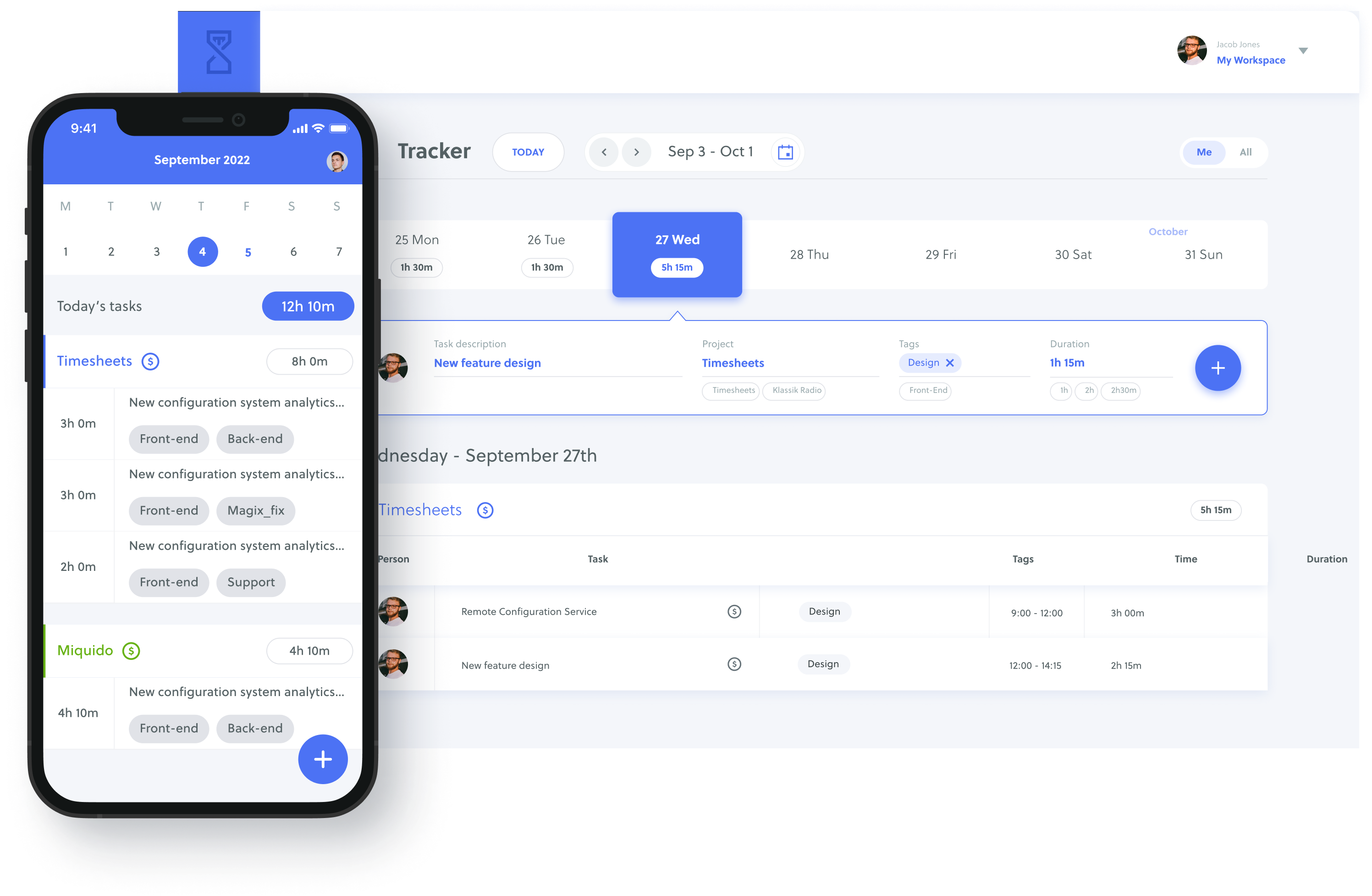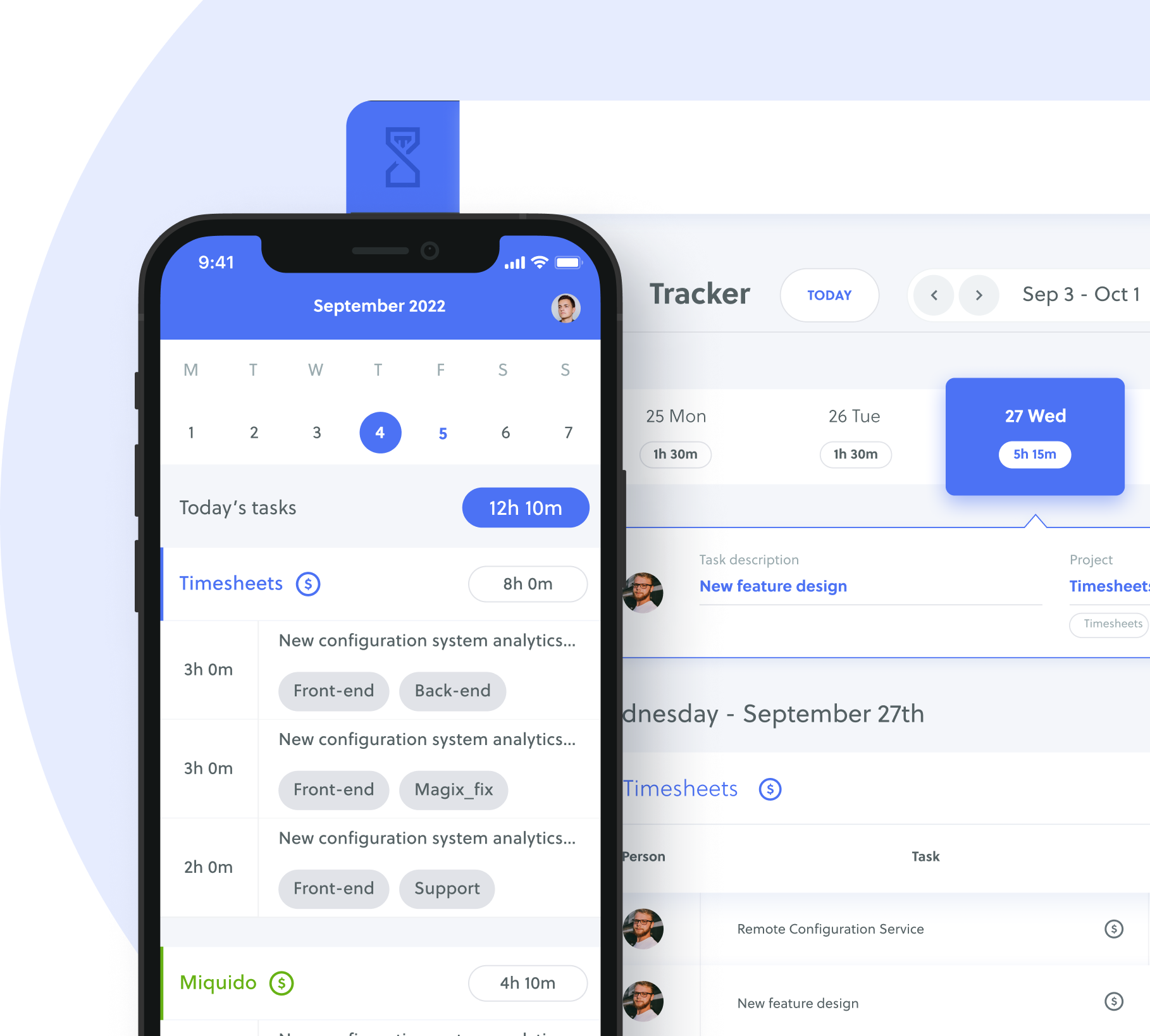The traditional eight-hour work schedule doesn’t work for every business. Whether you work in security or are expanding retail operations to capture more customers, you need an appropriate employee scheduling format to meet your unique business needs.
This article will explore an alternative to the 9-5 schedule, namely, the DuPont shift schedule. We will highlight how it works, its pros and cons, and ways to implement it that allow 24/7 operations without sacrificing employee wellness.
Table of Contents
What is the DuPont Shift schedule, and How Does it Work?
The DuPont shift schedule is named after the chemical company that first implemented it. It is a rotating work schedule where teams work three or four consecutive twelve-hour shifts followed by days off.
Here’s what that looks like,
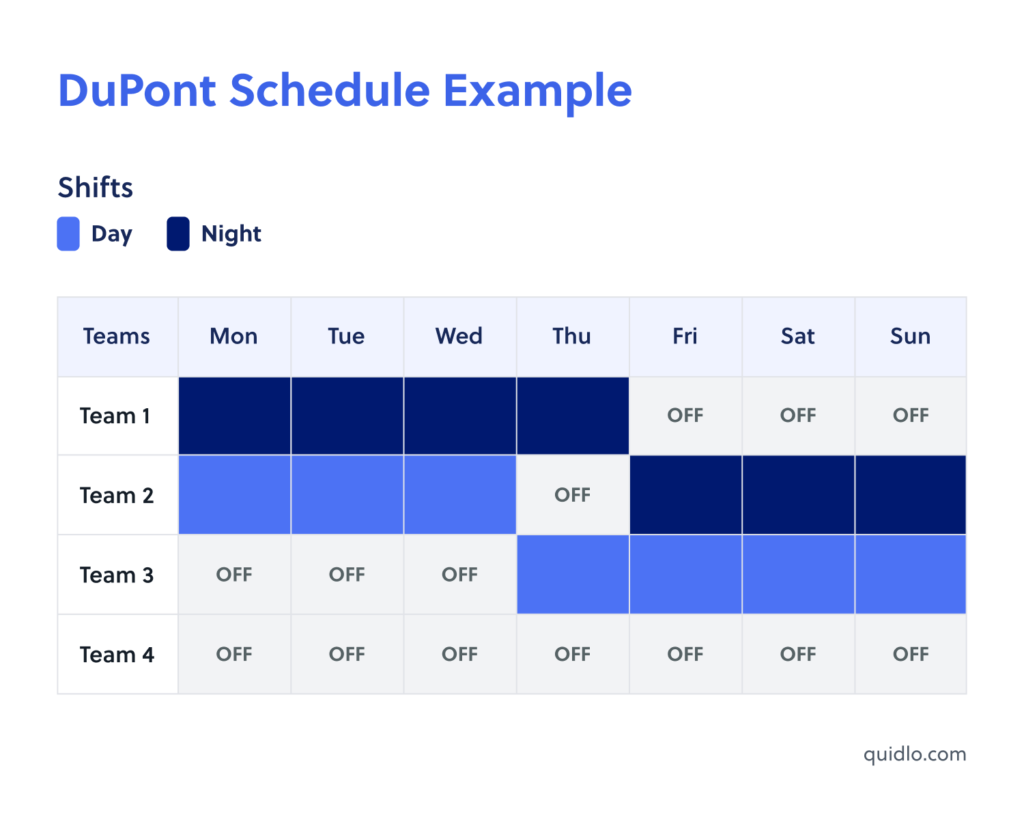
Compared to the typical work schedule where work days and hours are fixed, teams alternate between day and night shifts, depending on the week. The DuPont schedule follows a four-week cycle, using four teams for full coverage. Note that you’re not starting all groups on the same rotating shift pattern.
The first team works four consecutive night shifts with three days off. The second team works three-day shifts and three consecutive night shifts with a day off in the middle. The third team works four consecutive day shifts, and the fourth team has the entire week off.
At the end of the fourth week, all teams have gone through four different shift patterns, and the cycle starts again.
Advantages and Disadvantages of the DuPont Shift Schedule
As with most things, there are benefits and drawbacks to a 12-hour shift schedule like DuPont. Let’s start with the advantages.
Advantages of the DuPont Shift Schedule
Here are the reasons you might opt to use the DuPont schedule:
- No ‘Closed’ hours – The DuPont schedule allows your business to operate 24/7. Not only are you available when it’s convenient for your local customers, but you also open up your target market to a global audience.
- Longer off days – Where regular employees get eight days off per month, DuPont’s schedule rewards employees with 15 rest days. The extended time off makes planning vacations and personal appointments easy.
- Fair distribution of night shifts – Scheduling night shifts can be tricky. If you distribute them unequally, it could lead to low employee satisfaction and burnout. A rotating schedule distributes night shifts fairly, where each team receives the same number of night shifts.
So, not only does your business benefit from the DuPont schedule but so do your employees. You maximize profitability and revenue while your workers get more time for their personal lives.
Disadvantages of the DuPont Shift Schedule
The cons of adopting the DuPont shift are as follows:
- Shift coverage is a nightmare – The DuPont schedule is often set far in advance. If a worker on a team is absent for whatever reason, it is impossible to find someone from another team to cover for them without disrupting their rotation.
- Strenuous schedule – working a 12-hour shift length is physically and mentally challenging. While the DuPont shift pattern is predictable, it changes weekly, disrupting sleep patterns. Add a 72-hour work week, and employees can quickly burn out.
- Not for everyone – Workers with families may find that the DuPont schedule doesn’t align with their lifestyles. Furthermore, longer shifts aren’t recommended for physically demanding roles as they could lead to injury.
More revenue and more time off are all well good, but there are considerable downsides to this shift schedule.
Overtime with the DuPont Shift Schedule
On the DuPont shift schedule, employees work an average of 42 hours per week. However, the number of overtime hours isn’t two hours per week. A 12-hour shift means employees work four extra hours compared to the traditional shift length. As a result, you end up paying eight or 32 overtime hours per week.
Here’s the breakdown per week.
Week one: four 12-hour shifts for a total of 48 work hours. Overtime is eight hours.
Week two: six 12-hour shifts for a total of 72 work hours. Overtime is 32 hours.
Week three: four 12-hour shifts for a total of 48 work hours. Overtime is eight hours.
Week four: no work time, no overtime pay.
It doesn’t end there.
State laws on overtime vary. For example, Oregon calculates overtime after ten working hours and Colorado after 12 hours. Before implementing the Pitman schedule, study your local government’s labor laws.
What Industries use the DuPont Shift schedule?
So, which industries adopt a twelve-hour shift scheduling model? Check out the list below.
Hospitals
Emergency response
Power plants
Manufacturing companies
Gas stations
Convenience stores
These businesses require 24-hour coverage to maximize output and provide necessary services.
DuPont Shift Schedule Examples
Curious to see a real-life example of a DuPont schedule?
Below is a dispatch schedule for a security company.
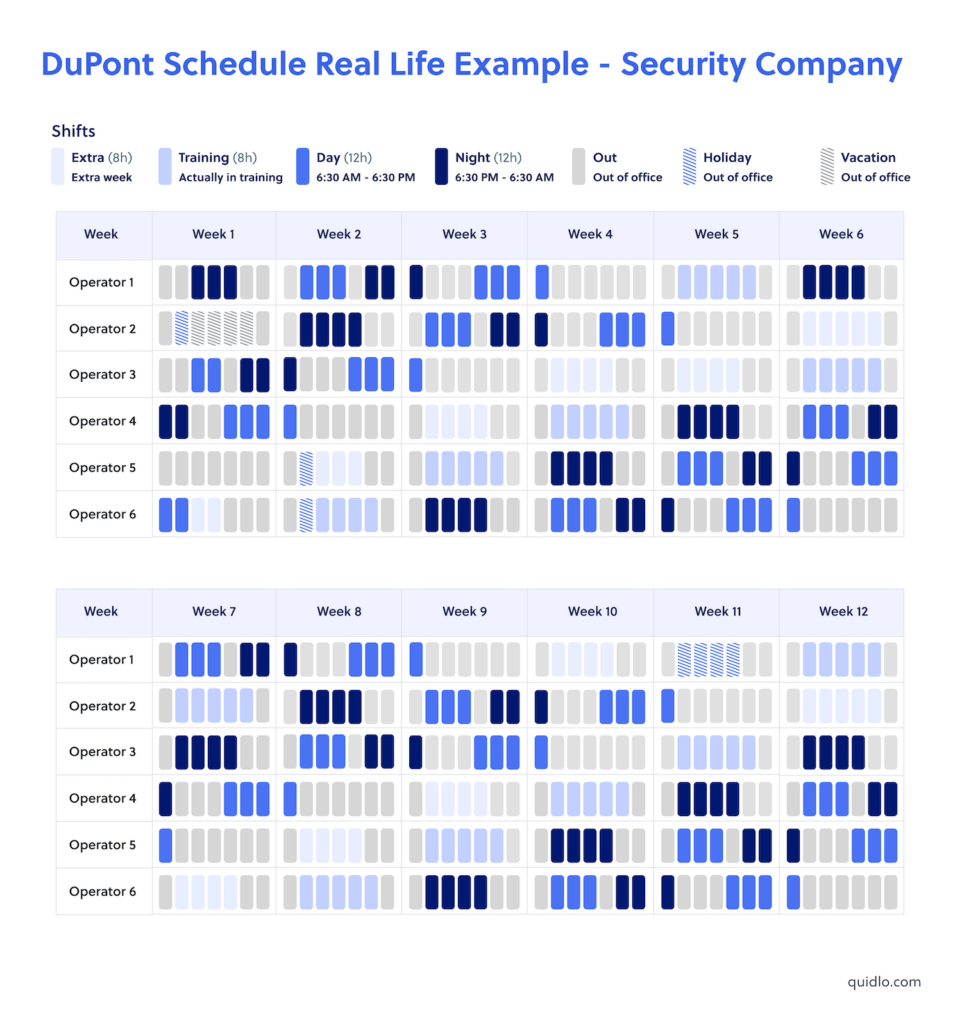
This example uses six operators to ensure round-the-clock staffing. The fifth and sixth operators mitigate the problem of shift coverage in case of sick or leave days.
The above example is a manager’s view. The schedule template below shows the DuPont work schedule from the employee’s perspective.
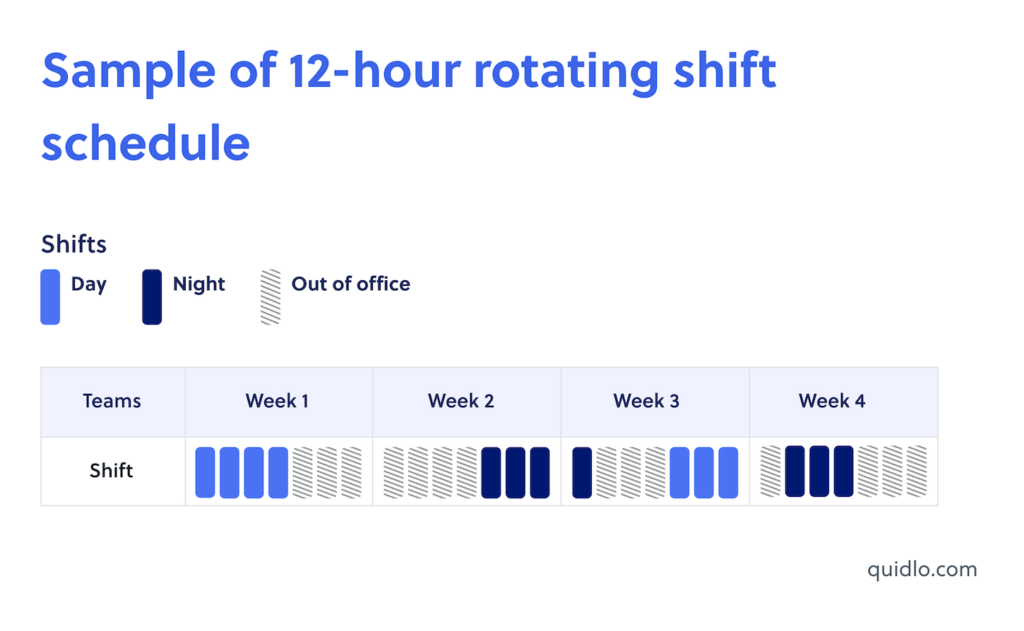
The simple layout makes it easy for relevant staff members to know which days and nights they work.
Is DuPont Schedule Bad for Health?
Working consecutive twelve-hour shifts is exhausting and physically challenging, but what are the health implications of a DuPont work schedule?
The biggest health concern for shift workers is shift work disorder. When employees work the night shift, many of them are awake outside of their natural sleep-wake cycle.
So, even if night shift workers have the recommended eight hours of sleep available, day sleeping is at odds with their sleep-awake rhythm. They can only get four to six hours of uninterrupted sleep, less if there are distractions or obligations at home.
A forward rotation (day to night shifts) helps minimize disruptions to sleep cycles, but rotating shift schedules inevitably include a backward rotation (night to day shift) which is associated with poor health outcomes.
A Medical News Today report on the health impacts of shift work shows that a lack of adequate sleep is associated with chronic illnesses such as heart disease, obesity, and some cancers. Poor sleep quality also increases the rates of workplace injury and mortality.
Things to Consider When Making a DuPont Shift Schedule
If you’re convinced that the DuPont shift schedule is right for your business, here are factors you should consider when creating twelve-hour shifts.
- Size of teams: You need four teams, but the number of team members depends on job or industry requirements. Remember that if a team member calls in sick, you will be hard-pressed to find a replacement. Be sure to have staff so that an absent employee doesn’t disrupt service delivery.
- Workload distribution: DuPont ensures fair and equal shift coverage, but the workload should be evenly distributed as well. You don’t want a situation where one or two teams do most of the heavy lifting.
- Employee buy-in: Adjusting to the DuPont schedule is challenging. More so for people with family obligations. Before introducing the new work schedule, speak to your employees and prepare them for the changes.
We recommend drawing up sample schedules and simulating worst-case scenarios. This helps visualize whether this type of work schedule works with your current staff. If you don’t have enough employees to pull it off, perhaps another rotating shift pattern would work.
Are There Other 12-Hour Shift Schedules?
DuPont shift schedules aren’t the only 12-hour shift available. Other alternatives include the Pitman schedule, the Panama schedule, and the Four on, Four off schedule.
The Pitman Schedule
This schedule follows a 14-day cycle, where teams work two to three consecutive day and night shifts. Workers keep the same shift sequence throughout the cycle before their team rotates. Some companies adopt a fixed version of this schedule with permanent day and night teams.
Here’s an example,
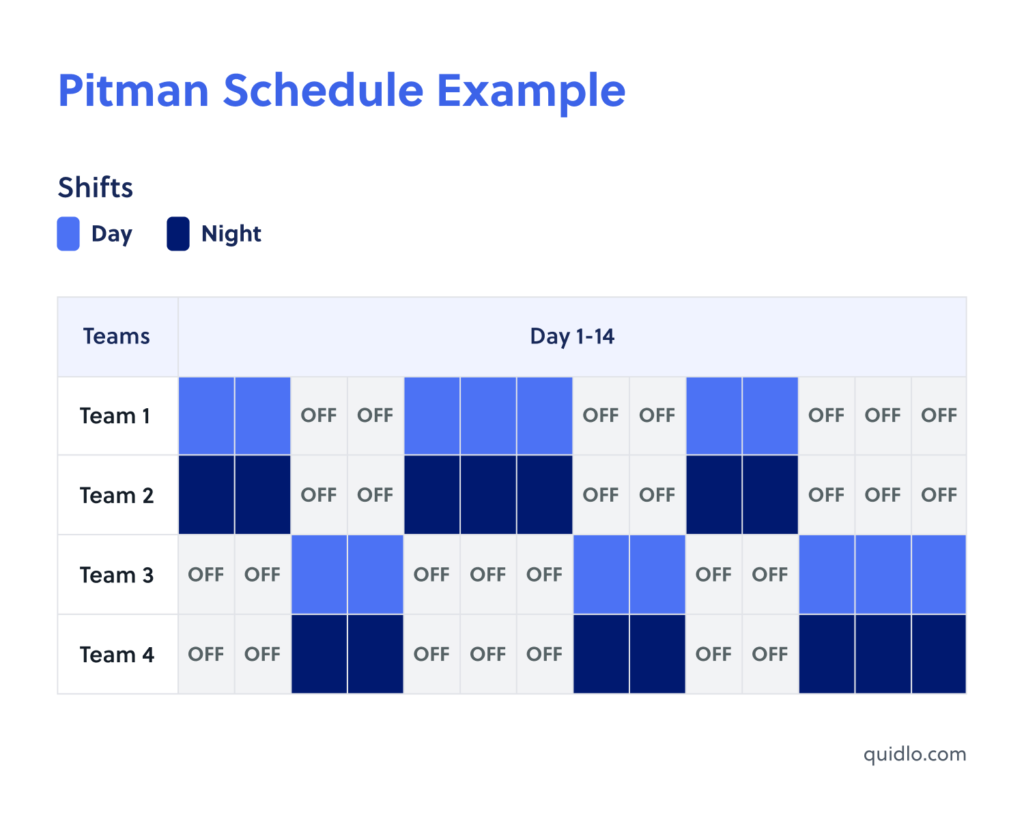
Unlike the DuPont schedule, this schedule has a slow rotation, giving workers time to adjust to the new schedule. Employees also get fourteen days off a month.
On the downside, the slow rotation means night shift workers keep those shifts for two weeks or permanently if the schedule uses the fixed version.
The Panama Schedule
In this schedule (also known as 2-2-3), four teams work two consecutive day or night shifts, rest for two days, and then work three consecutive shifts.
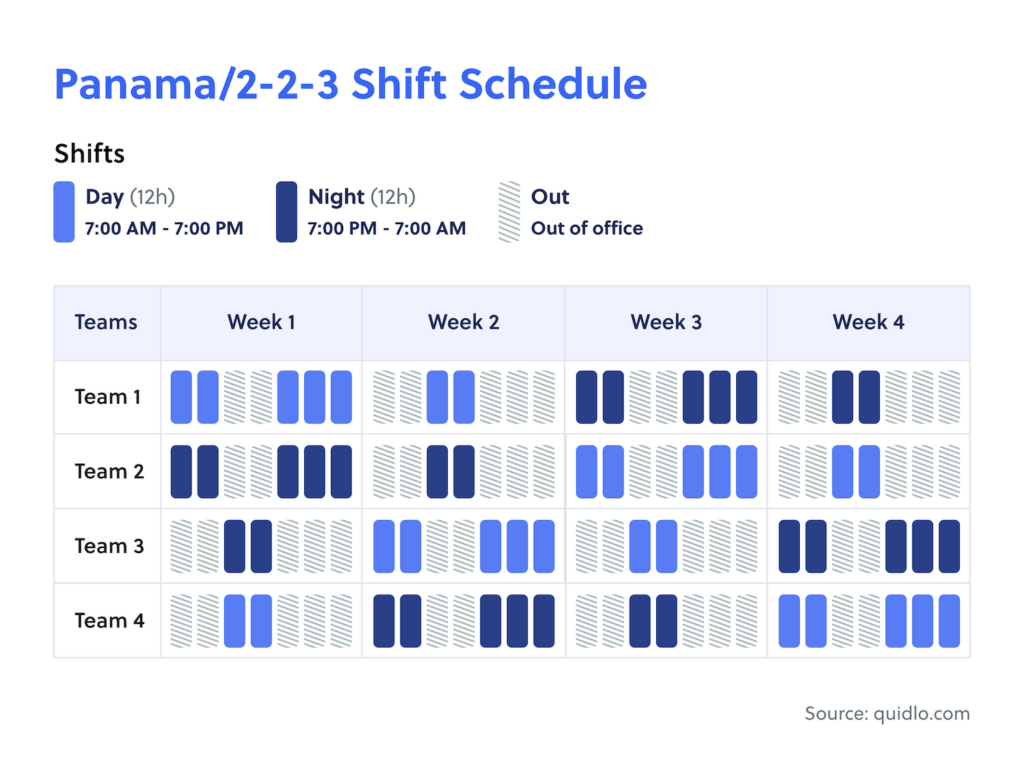
The Panama schedule is similar to the Pitman rotating schedule, except it follows a four-week cycle. Workers keep the same rotating shift pattern throughout the four weeks, then switch.
In the Pitman schedule, teams rotate after 14 days. This slow rotation gives workers more stability for planning their personal lives.
Four on, Four off
This shift schedule is straightforward. Employees work four consecutive shifts and take four days off on a repeat cycle every eight days.
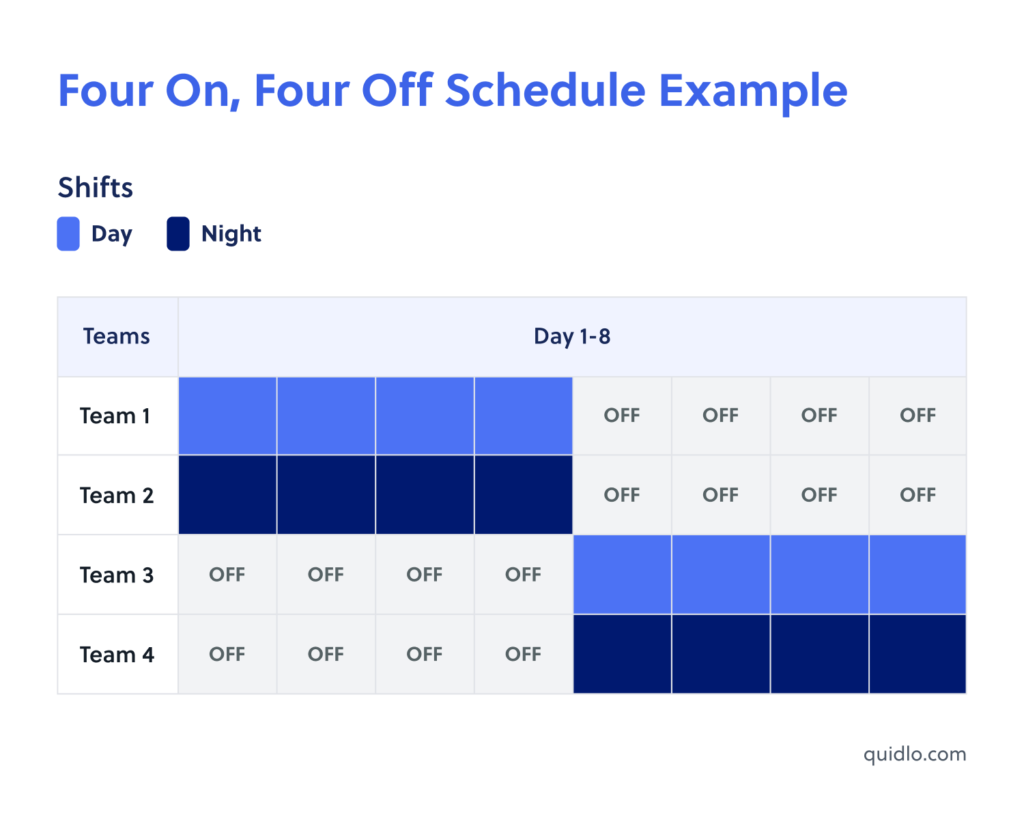
This schedule gives workers plenty of rest time, and the average hours of overtime are 32, as opposed to DuPont’s 48 overtime hours. However, mapped onto the seven-day calendar, employees’ days off vary from work to work. Not to mention, four consecutive night shifts are physically and mentally taxing.
What are the Other Alternatives?
The overtime expenses of twelve-hour schedules are cost-prohibitive for many businesses looking to scale to 24-hour operations. Here are schedule alternatives to help you achieve round-the-clock coverage without busting your labor budget.
- 4-10 shift schedule: employees work 10-hour shifts over four consecutive days. Ten hours are less physically and mentally taxing than 12 hours, and workers get a three-day weekend. Depending on your state, you don’t have to pay overtime since workers work 40 hours per week.
- 9-80 shift schedule: employees work 80 hours over nine days. The goal is to have workers put in less than ten work hours with eight nine-hour shifts and one eight-hour day. Again, your labor costs are safe from overtime expenses.
It is also possible to achieve 24/7 coverage on eight-hour shifts. Instead of two shifts, create three.
DuPont Shift Schedule: Wrap-Up
The DuPont shift schedule is an effective solution for businesses operating around the clock. It ensures 24/7 coverage, minimizes work stoppages, and maximizes output.
We covered how the DuPont schedule works, the advantages and disadvantages, and critical factors to consider when implementing this schedule. We also shared six alternative scheduling models to guide you in choosing the correct employee schedule for your business.
Whether you choose the DuPont schedule or another rotating shift model, rotating schedules can complicate payroll processing. That’s why you need time-tracking tools like Quidlo Timesheets to simplify regular and overtime calculations, ensuring accurate labor costs.






